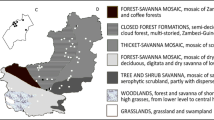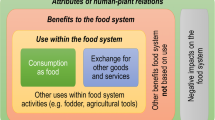Abstract
The indigenous people of Australia have a long and well documented history of using native plants as an essential component of their customary economy. However, few have engaged successfully in commerce based on native plant use. Recently there has been an increasing interest in exploring options for use of native plants for food, food additives, botanical medicines, and related purposes. In this paper, we determine the issues important to Aboriginal people in enterprise development utilizing plant products, and we define some of the factors affecting progress in realizing opportunities. The Aboriginal people with whom we have worked appear to prefer small-scale enterprises where they have community ownership of ideas and control of the rate and direction of development. Government could play a larger and more active role through supporting additional research and marketing information, providing training, and better matching policy and legislation to support indigenous development and reduce dependence of welfare.
Similar content being viewed by others
Literature Cited
Altman, J.C., B.H. Hunter, S. Ward, and F. Wright. 2002. Some competition and consumer issues in the indigenous visual arts industry. Centre for Aboriginal Economic Policy Development, Discussion Paper 235/2002, Canberra.
—, and M. Gray. 2005. The CDEP scheme: A flexible and innovative employment and community development program for indigenous Australians. In Transition and Risk: New Directions in Social Policy, Centre for Public Policy Conference (25-27 February 2005), University of Melbourne, Victoria, Australia.
Australian Government. 2006. CDEP Guidelines 2006-7: Employment and Workplace Relations Series for Australians, http://www.workplace.gov .au. Canberra.
Belcher, B., M. Ruiz-Perez, and R. Achdiawan. 2005. Global patterns and trends in the use and management of commercial NTFPs: Implications for livelihoods and conservation. World Development 33(9): 1435–1452.
Brand, J.C., V. Cherikoff, and A. Lee. 1982. An outstanding source of vitamin C. Lancet 2(8303):873.
Brock, J. 2001. Native plants of northern Australia. Reed New Holland, Sydney.
Campbell, B.M., and M.K. Luckert. 2002. Uncovering the hidden harvest: Valuation methods for woodland and forest resources. Earthscan Publications, Ltd., London.
Collins, B. 2000. Kakadu Region social impact study community report. Report on initiatives from the Kakadu Region community and government, on the implementation of the Kakadu Region Social Impact Study, November 1998-November 2000. Parks Australia North, Darwin.
Coradji Pty Ltd. 2003. Patent for (54) Fruit Processing Device. Australian Official Journal of Patents, 7 August 2003 (2003903791).
Cowie, I.D., P.S. Short, and M. Osterkamp Madsen. 2000. Floodplain flora: A flora of the coastal floodplains of the Northern Territory, Australia. Australian Bureau of Resource Sciences, Supplementary Series No. 10, Canberra.
Dale, A. 1996. Community-based planning in establishing wildlife projects. Pages 110–125 in Mary Bomford and Judy Caughley, eds. Sustainable use of wildlife by Aboriginal peoples and Torres Strait islanders. Bureau of Resource Sciences, Canberra.
Dunlop, C.R., G.J. Leach, and I.D. Cowie. 1995. Flora of the Darwin Region. Conservation Commission of the Northern Territory, Darwin.
Griffiths, A.D., J.H. Schult, and J.T. Gorman. 2005. Wild harvest ofCycas arnhemica: Impact on survival, recruitment and growth in Arnhem Land, northern Australia. Australian Journal of Botany 53:771–779.
Hill, K.D., and R. Osborne. 2001. Cycads of Australia. Kangaroo Press, Sydney. Hunter, B.H. 2002. The rise of the CDEP scheme and changing factors underlying indigenous employment. CAEPR Working Paper No. 13/2002, Canberra.
Lindsay, B.Y., K. Waliwararra, F. Milijat, H. Kuwarda, R. Pirak, A. Muyung, E. Pambany, J. Marryridj, P. Marrfurra, and G. Wightman. 2001. MalakMalak and Matngala plants and animals - Aboriginal flora and fauna knowledge from the Daly River area, northern Australia. Conservation Commission of the Northern Territory, Darwin.
Low, T. 1991. Wild food plants of Australia. Angus and Robertson, Sydney.
Marrfurra, P., M. Akanburru, M. Wawul, T. Kumunerri, H. Adya, K. Kamarrama, M. Kanintyanyu, T. Waya, M. Kannyi, G. Wightman, and L. Williams. 1995. Ngan’gikurunggurr and Ngan’giwumirri ethnobotanical Aboriginal plant use from the Daly River area, Northern Territory. Conservation Commission of the Northern Territory, Darwin.
Marshall, E., A.C. Newton, and K. Schreckenberg. 2003. Commercialisation of non-timber forest products: First steps in analysing the factors influencing success. International Forestry Review 5(2): 128–137.
Morphy, F., and W. Sanders, eds. 2001. The indigenous welfare economy and the CDEP scheme. In Research Monograph No. 20. Centre for Aboriginal Economic Policy Research, Australian National University, Canberra.
National Forest Inventory. 2003. Australian state of the forests report 2003. Bureau of Rural Sciences, Canberra.
O’Faircheallaigh, C. 1988. Uranium royalties and Aboriginal economic development. In D. WadeMarshall and Loveday P., eds. Contemporary issues in development. North Australian Research Unit, Australian National University, Darwin.
Parks and Wildlife Service Northern Territory. 2003. A management program for cycads in the Northern Territory of Australia. Government Printer of the Northern Territory, Darwin.
Pimentel, D., M. McNair, L. Buck, M. Pimentel, and J. Kamil. 1997. The value of forests to world food security. Human Ecology 25(1):91–120.
Raymond, E., J. Blutja, L. Gingina, M. Raymond, O. Raymond, L. Raymond, J. Brown, Q. Morgan, D. Jackson, N. Smith, and G. Wightman. 1999. Wardaman ethnobiology. Government Printer of the Northern Territory, Darwin.
Russell-Smith, J., P.G. Ryan, D. Klessa, G. Waight, and R. Harwood. 1998. Fire regimes, firesensitive vegetation, and fire management of the sandstone Arnhem Plateau, monsoonal northern Australia. Journal of Applied Ecology 35:829–846.
Schaper, M. 1999. Australia’s Aboriginal small business owners: Challenges for the future. Journal of Small Business Management 37(3):88–94.
SRRATRC. 1998. Commercial utilisation of Australian native wildlife. Report of the Senate Rural and Regional Affairs and Transport References Committee. Parliament of the Commonwealth of Australia, Canberra.
Turnbill, S. 1980. Economic development of Aboriginal communities in the Northern Territory. 1. Impact of mining royalties, 2. Self-sufficiency (with land rights). Department of Aboriginal Affairs, Darwin.
Wightman, G., and N. Smith, n.d. Ethno-botanical database. Northern Territory Herbarium, Department of Natural Resources, Environment, and the Arts, Darwin (unpublished).
Woinarski, J., K. Brennan, C. Hempel, R. Firth, and W. Watt. 2000. Biodiversity conservation on the Tiwi Islands: Plants, vegetation types and terrestrial vertebrates on Melville Island. A report for Tiwi Land Council, Parks and Wildlife Commissions of the Northern Territory.
Woods, B. 1995. A study of the intra-specific variations and commercial potential ofTerminalia ferdinandiana (Excell) (the Kakadu plum). M.Sc. Thesis. Northern Territory University, Darwin.
Yibarbuk, D.M., P.J. Whitehead, J. Russell-Smith, D. Jackson, C. Godjuwa, A. Fisher, P. Cooke, D. Choquenot, and D.J.M.S. Bowman. 2001. Fire ecology and Aboriginal land management in central Arnhem Land, northern Australia: A tradition of ecosystem management. Journal of Biogeography 28:325–44.
Author information
Authors and Affiliations
Corresponding author
Rights and permissions
About this article
Cite this article
Gorman, J.T., Griffiths, A.D. & Whitehead, P.J. An analysis of the use of plant products for commerce in remote aboriginal communities of northern Australia. Econ Bot 60, 362–373 (2006). https://doi.org/10.1663/0013-0001(2006)60[362:AAOTUO]2.0.CO;2
Received:
Accepted:
Issue Date:
DOI: https://doi.org/10.1663/0013-0001(2006)60[362:AAOTUO]2.0.CO;2




